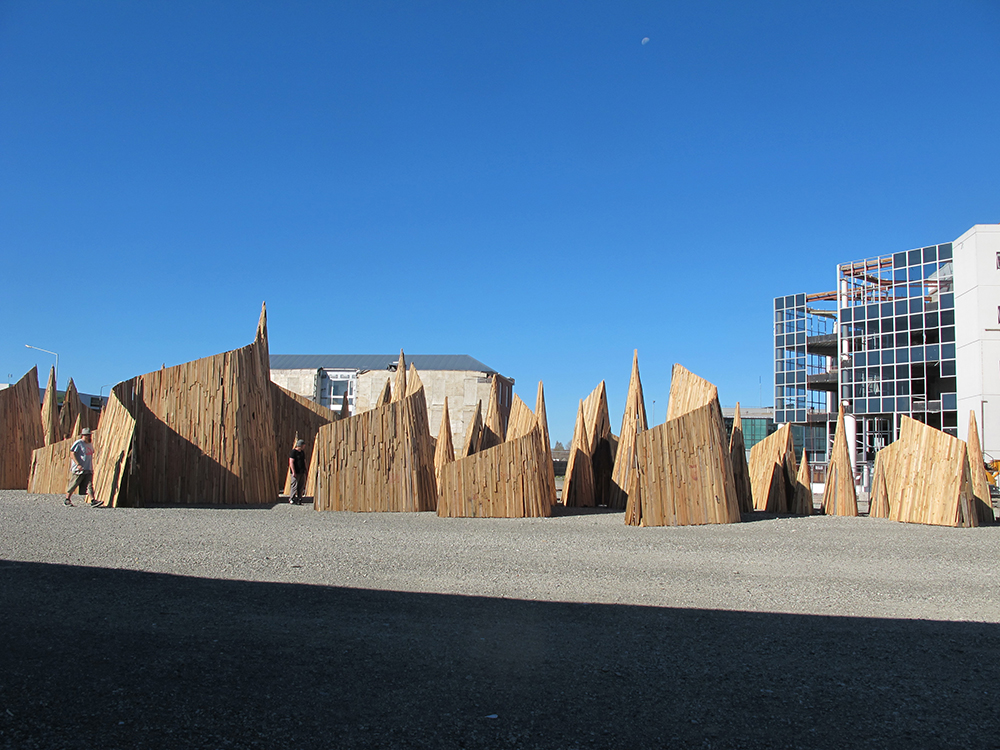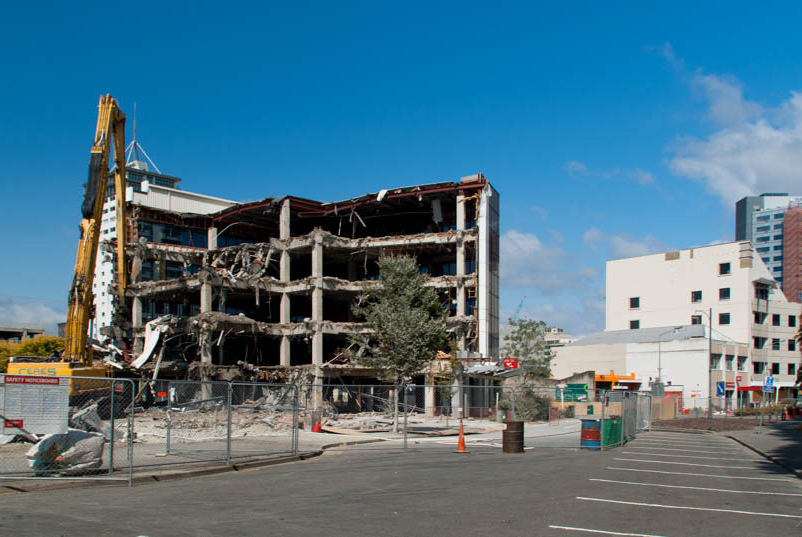Transitional Architecture in Christchurch

Our world is made better by those who throw caution to the wind to do what they love. Put a person like architect, urbanist and publisher Barnaby Bennett in the middle of a catastrophic natural disaster and what you get is an inspired revisioning of a city and what it means to belong. Between September 2010 and February 2011 Christchurch was hit by two earthquakes. The first was an unnerving near miss – without any fatalities, a creative energy emerged amongst young architects, designers and activists inventing ways to fill in the gaps left on the main street. Gap Filler and other grassroots collectives emerged, redefining the city on their own terms. Built over rubble, the outdoor Dance-O-Mat was one of the first ‘transitional’ initiatives. With disco lighting strung on tall poles and a laundromat washing machine repurposed as a jukebox, the city had a place to dance, without any rules, to its own music.

But on February 22nd 2011, the second quake, with a death toll of 185, put a pall over any festive atmosphere. For the now almost flattened city centre, larger and more complex questions arose about what the city would or could become. The process of envisioning, planning and re-building was going to take time and interim solutions were sought to help stop a tide of rushed planning approvals and hasty construction. From this, a new building typology emerged; an architecture of impermanence, spontaneity and ingenuity. Defining and celebrating this movement is a publication from Project Freerange, Christchurch: The Transitional City; and, the now annual Festival of Transitional Architecture (FESTA); a vehicle for ploughing the field of experimental and progressive approaches to urban renewal. At the creative heart of all this cultural production is Barnaby Bennett, founder of Project Freerange, author of Christchurch: The Transitional City and an instigator and key protagonist of FESTA.
I met with Barnaby last year in Sydney where he’d presented a chapter of his PhD thesis on just this topic. Two years on, the impact of the second more devastating Christchurch earthquake is more than palpable.
Genevieve Murray
Rewind to September 2010 and the initial earthquake that hit Christchurch. What was the impact that this had on the city?
Barnaby Bennett
Well, I wasn’t living there at the time and I think I probably shared a similar feeling to anyone that wasn’t there, that it was a passing curiosity. Because of the miracle of no one dying, the earthquake’s severity wasn’t taken seriously by a lot of people. I think that people in the city felt they’d dodged a bullet. I visited in December after the initial quake and there was quite a big aftershock. There was always this sense that there might be a few more earthquakes; that a few more buildings would have to come down, that there’d be consequences and it’d be expensive. But I don’t think anyone really realised or expected the giant crisis that came.

GMWhat have been the great losses?
BBWell, apart from the lives, the stress, the loss of half the heritage in the city and the entire built fabric and the 20 billion of government money – I mean it’s loss everywhere you look. The head planner came and talked to us at architecture school and said look, I wouldn’t want to wish this on anyone. This has been a horrific, difficult, highly stressful, incredibly painful and sad time. But, while saying that, you try and turn it around as much as you can and turn it into a positive opportunity. So within that, there’s the potential for Christchurch to learn some really strong lessons that maybe other people around the world can benefit from.

GMOut of the earthquake came a positive and at times, activist response to dealing with life in a city that had lost 80% of its building stock. Citizens, architects and designers took over vacant lots with creative intentions. Where did this movement come from and how did it change the atmosphere of the city?
BBWell, not being there for the first year, I can’t talk with intimate knowledge of it. But in terms of where the movement came from, I guess there are lots of answers to that. The easy one is that there were lots of individuals and groups, like Gap Filler, that pioneered a few moves. Gap Filler’s original concern, actually, was that they thought a whole lot of low-quality construction was going to be put up pre-2011 Rugby World Cup, to try and quickly get the city looking ‘nice’ again. No one knew the February quake was going to happen at that point.
I think after February, everything completely changed. The mood of Gap Filler completely changed – it stopped being so festive. And a lot of the cultural amenity was no longer that important. And actually, a lot of the really interesting stuff that happened in the first three or four months was out of necessity, out of communities gathering together. There are some really beautiful installations around: people supplying water out of backyard springs to passers by. A whole lot of necessity drove it for a long while. There was a utopian aspect – everyone got to know their community and neighbours. The government wasn’t able to play a particularly active role because they were preoccupied with trying to deal with what they had. So, with the combination of a few strong leaders and a sense of ‘this as our city’, I think what came out of that time was a spirit of ‘we can do stuff’, we don’t need permission – we’ve proven it to ourselves.

GMDid this ‘movement’ of people engaging with the city and doing temporary installations come off the back of the idea that the city could be re-imagined?
BBSome of it was probably opportunistic. There was stuff like skateboarding and illegal street art…There were some really exciting and interesting discussions and wild ideas about what Christchurch could become – a spirit of that in the first six months. And the council ran quite a bold project, which has just won a big international competition, called Share An Idea. And that’s been the only public consultation that’s happened through the entire process.

GMGoing back to 2007, you were a founding member of Freerange Press. How did this come about and why?
BBWhen we were undergrads we had talked about starting a magazine as a student body and never got round to it. Then, at Global Studio in Vancouver I realised there was just this enormity of interesting people out there and I was trying to find an excuse to keep us all in touch… I thought, why not do a free online publication every couple of months and just gather what people are writing about and make it really nicely designed, create a PDF, get a website and make it free. So that was the ‘free’ in Freerange. As time has gone on, the model has changed a bit and it’s grown into more of a conventional publishing house.
GMYou’ve had people contribute from all over the world. So it’s a global network of people who are thinking on the edge of architecture, design and the city?
BBActually, it’s less about architecture and more about talking about urbanism from as many different perspectives and disciplines as we can. The most global problems are urban problems now, we increasingly live in cities and there’s a sort of commonality around that. So the Freerange byline is the City, Design, Pirates and Politics. And then we lay a theme over that.
GMWhat connects the dots between all the work you’ve done?
BB(Laughs) Probably just me. What is quite strongly absent is a normal conventional practice. What connects it all is the curiosity about where skills can go and what sort of things you can do. So I’ve done things like being involved with street festivals and publications and other things that I think are very much using the skills of an architect but probably in a less committed way than working in a firm.
GMThe book Freerange Press published on the Transitional City defines the movement within the urban sphere in Christchurch. When did it become an identifiable movement and not just a collection of projects?
BBIn these complex, fluid and unpredictable circumstances, it is as much the documentation and the representation of things that define how it’s understood. So, the book I think, solidified the feeling people already had about what was going on. It’s quite a simple document, it brings together a whole lot of strands and threads that weren’t in the same frame before. We didn’t make any distinction between architecture, event, performance, art, construction, it just needed to fulfil our criteria. It had to be post-quake, it needed to be impermanent, it needed to be on public space – we included it if it fulfilled those. So the projects range from street art to stadiums. We didn’t come up with the phrase ‘transitional’, council did, but out of the book there comes a sense that there is a movement, and around that there’s a whole explosion of things like Life in Vacant Spaces, Greening the Rubble, and Gap Filler and FESTA.

GMIs it impossible for an organisation to be nimble? Is there key legislation that could change the way our public spaces are used and how we engage with them?
BBI always think about a British guy called Colin Ward who died a few years ago. He was an anarchist, and he always talked about the best anarchist organisations as being small, temporary, voluntary, and non-hierarchical. I think councils can go about it that way, by supporting little things that are allowed to fail, that can emerge then disappear. They have all the characteristics that councils don’t have and that council can’t afford, economically or politically because things need to be sound and stable and present and publicly accessible. I think it’s important that these things are the opposite of councils. But can still co-exist with them.
GMSo is it about council shifting their outlook and saying, we are not controllers but facilitators?
BBPart of it.

GMWhat do you hope future plans of the city will take from this movement?
BBI think the city is at a very dynamic point. The hopes we had for it I think are happening, which is that council is taking very seriously the transitional projects and putting in funding and schemes to support them, and the central government, which had previously being uninterested, is starting to realise their plans are going to take six, seven, eight years to implement. So there needs to be more activity immediately, particularly as the cordoned-off zone has now been removed. And that’s our immediate intentions, the five year window, we’ve got no idea what the city is going to be in ten years… we’re quite open about not knowing.
Many thanks to Barnaby Bennett. For more information on Barnaby’s work and the transitional architecture movement in Christchurch and beyond, check out Project Freerange and FESTA.




